World View
Religious Demography of the World
As we have described above, the religious demography of India has changed significantly during the twentieth century. Between 1891 and 1991, the share of Indian Religionists in the population has declined from 79 to 68 percent. This loss of more than 11 percentage points has been largely to the gain of adherents of Islam, whose share has risen from less than 20 percent to about 30 percent, and who have consequently been able to carve out two separate countries for themselves, taking away almost one fifth of the population and somewhat more than one-fifth of the area of pre-Partition India. Christians have enhanced their share less spectacularly, from about 0.7 percent to about 2 percent; but they have also been able to carve a significant pocket of Christian dominance on the northeastern and southern borders of Indian Union.
To understand the significance of these momentous changes, it is important to put the Indian situation in the context of the changes in the religious demography of the world during the twentieth century. The changes everywhere, as in India, involve a decline in the share of native religionists, as Islam and Christianity, the two great proselytising religions of our times, make deeper inroads into different regions of the world.
Censuses of different countries use different categories and methods for classifying populations according to religion. A uniform picture of the religious demography of all countries of the world was compiled in the World Christian Encyclopaedia, published in 1982; a new edition of this encyclopaedia has been published recently2 . We use this source to obtain religious composition of the populations of different continents of the world in 1900, 1970 and 1990.
There are, however, several problems in using the figures provided in the Encyclopaedia for the religious distribution of the populations of the world. The Encyclopaedia is compiled and published essentially as a reference manual for Christian proselytising missions all over the world. It attempts to statistically record the successes achieved by such missions and portray the challenges before them. It, therefore, tends to overestimate the number of Christians, especially in non- Christian parts of the world. The number of Christians, and even Muslims, in non-Christian parts of the world recorded in the Encyclopaedia is often larger than the number counted in the official censuses of various countries. In addition, it records a category of secret Christians, called crypto- Christians, whose existence is known only to the Church. For 1990, the Encyclopaedia counts about 103 million crypto-Christians in the world; of these 94 million are in Asia and about 7 million in Africa.
The Encyclopaedia also tends to divide the native religionists of non-Christian parts of the world into groups like “Ethnic Religionists” and “New Religionists”, thus counting them out of the mainstream religion of the region. For 1990, it counts about 200 million persons as Ethnic Religionists; of these about 118 million are in Asia and about 80 million in Africa. New Religionists counted in 1990 add to 92 million, almost all of them in Asia.
Finally, the Encyclopaedia counts large numbers under the categories of Non-Religious persons and Atheists. In 1990, there are about 707 million persons counted as Non-Religious and another 146 million as Atheists. A majority of these are in countries that are or were under Marxist states. There are also about 58 million people counted as Non-Religious or Atheists in other parts of Europe, about 25 million in North America and about 16 million in Japan.
We assume that people counted under the categories of crypto-Christians, Ethnic Religionists, New Religionists, Non-Religionists and Atheists in non-Christian regions of the world are part of the mainstream native religion of the relevant region or country. We also assume that Non- Religionists and Atheists in Christian regions of the world, as also the few New Religionists there, are Christians, though they may not be regular participants in the Church. These assumptions are similar to the assumptions about Indian Religionists that we have made in our analysis of the religious demography of India earlier; these assumptions allow us to make a clear assessment of the decline of native religions and corresponding progress of Christianity and Islam in different regions of the world. Incidentally, outside South Asia, we do not count Buddhists among Indian Religionists, and the term includes only Hindus, Sikhs and Jains. We apply these assumptions to obtain religious profiles of different continents of the world.
Asia
Asia is the most populous continent of the world. In Table 10, we have compiled a brief religious profile of Asia.
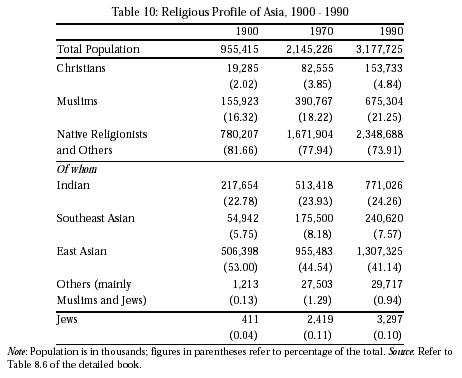
Looked at from the perspective of Asia as a whole, Islam and Christianity seem to have made significant though not spectacular progress during the twentieth century. The share of Christians in the population has gone up from 2.02 to 4.84 percent; their share in 1990, however, is nearer 8 percent, if we count the crypto-Christians of the Encyclopaedia as Christians. Muslims have gained by about 5 percentage points, with their share going up from 16.32 to 21.25 percent; the gain turns out to be higher by about 1 percentage point, if we include the West Asian and Central Asian people counted as Atheists and Non-Religious amongst them.
Christian and Muslim gains are concentrated in specific countries. Of about 154 million Christians in Asia, about 55 million are in Philippines, the only country that had a significant Christian presence in 1900. Of the rest, about 22 million are in India, almost all of them in Indian Union; about 18 million in Indonesia; and about 17 million in South Korea. South Korea, Indonesia, and to a lesser extent Indian Union, are the main success stories of Christian proselytising in Asia during the twentieth century. Myanmar, Taiwan, Malaysia, Thailand, and perhaps, Japan are the other countries in Asia where Christians have made some headway.
Of about 675 million Muslims in Asia, about 230 million are in the historically Muslim countries of West and Central Asia. Of the rest, about 325 million are in South Asia, almost all of them in India, including Indian Union, Bangladesh and Pakistan, each of which accommodates about a hundred million Muslims. Another about 100 million Muslims are in Indonesia. India and Indonesia are the only two parts of Asia where Muslims have made major gains during the twentieth century; in India their presence has increased by about 8 percentage points, from about 22 to 30 percent, and in Indonesia, their share has gone up from about 40 to 55 percent.
There are also 3.30 million Jews in Asia; of these 3.16 million are in West Asia, most of them in Israel and Palestine. Their share in the region has almost doubled during the twentieth century, with the creation of Israel. The share of Indian and Southeast Asian Religionists in the population of Asia has slightly improved; this is largely because East Asian countries have had a relatively lower rate of population growth. Unlike India, China, the most populous country of East Asia, however, seems to have provided no ground for the growth of Islam or Christianity; absolute number of Muslims in China has declined since 1900 and the share of Christians in the population has come down from already insignificant 0.4 percent in 1900 to 0.2 percent in 1990.
Africa
Unlike Asia, Africa has seen a major transformation of its religious demography in the course of the twentieth century. The native religionists of the continent have been largely converted to either Christianity or Islam. The Arab North Africa was the only region that had a predominantly Muslim population in 1900; native religionists dominated the other regions of Africa. In 1990, North Africa remains largely Muslim, as it was at the beginning of the twentieth century; South and Central Africa have been claimed almost entirely by Christianity; East Africa has become two-thirds Christian; and West Africa has been divided between Christianity and Islam, with Muslims dominating the northern countries of the region. In Table 11, we have compiled a brief religious profile of the population of African continent.
Total population of Africa has grown faster than that of Asia and the world; the growth has been especially fast between 1970 and 1990. Population of the continent multiplied by a factor of 3.3 between 1900 and 1970, and it has multiplied again by 1.7 between 1970 and 1990.
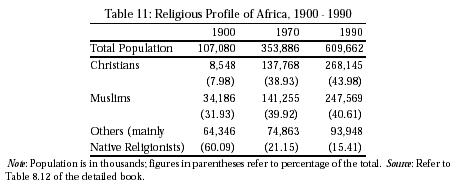
Of 609 million persons in the continent in 1990, about 268 million are Christians and 248 million Muslims. The proportion of Native Religionists in the continent has come down from about 60 to 15 percent in the course of the twentieth century. The remaining population of the continent has been almost equally divided between Christians and Muslims, with the former claiming about 44 percent and the latter about 41 percent.
Europe
Europe is a Christian continent. In 1900, almost 95 percent of the people of Europe were Christians. In Table 12 we have compiled a brief religious profile of Europe.
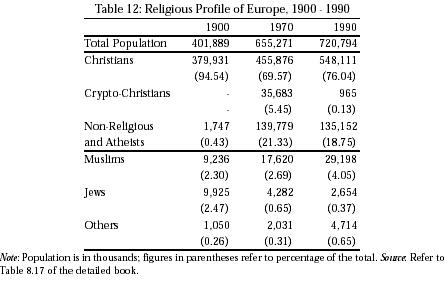
Europe remains a Christian continent; no other religion of the world has made any major headway there. Apparently, the proportion of Christians in the population of Europe has declined considerably in the course of the twentieth century. But, the change is mainly because of the large number of persons counted as crypto-Christians in 1970 and as Non-Religious, Atheists and New Religionists in both 1970 and 1990. This does not seem to suggest any serious conversion away from Christianity.
A majority of the people counted under these categories happen to be in the formerly communist countries of East Europe, where people until recently were under pressure of the state not to declare their religious inclinations. In 1970, of about 36 million persons counted as crypto-Christians, 31 million were in East Europe. By 1990 the number of crypto-Christians in Europe has already declined to less than a million, and most of them have probably been now counted as Christians.
Of about 135 million people counted as New Religionists, Non-Religious or Atheists in 1990, about 77 million are in East Europe. Many of these people also seem to be returning to Christianity; the percentage of persons counted under these categories in Eastern Europe has declined from 37 percent in 1970 to about 25 percent in 1990.
There are also significant numbers in other parts of Europe who have begun to declare themselves as non-religious or atheists under the modern liberal influences of the twentieth century. In 1990, there were about 16 million persons counted under these categories in South Europe, about 30 million in West Europe and about 13 million in North Europe. All of them, however, remain part of the mainstream Christian milieu of Europe, and are probably better defined as non-Church-going Christians.
If we count the persons enumerated under the categories of crypto-Christians, New Religionists, Non-Religious and Atheists, etc., along with Christians, then the share of Christians in the population of Europe seems to have remained steady at about 95 percent throughout the twentieth century. In 1990, of 720 million people in Europe, 684 million belong essentially to the Christian faith.
In 1990, there are about 29 million Muslims in Europe. They have improved their share in the population of Europe from about 2.3 percent in 1900 to 4 percent now. Much of the rise in Muslim presence has occurred between 1970 and 1990; in 1970 their share in the population was 2.7 percent, only slightly above their share in 1900.
About half the Muslims, amounting to about 14 million, are in East Europe, almost all of them in Russian Federation, Ukraine and Bulgaria. This region has always had a significant presence of Muslims; their share in the population of the region has remained around 4.5 percent throughout the twentieth century. There are another about 6 million Muslims in South Europe; most of them are in the Balkan countries that have been carved from former Yugoslavia and in Albania, but there are also about 0.6 million Muslims in Italy forming about 1 percent of the population there. There are almost no Muslims in Spain and Portugal, the countries that had once been conquered by Islam.
West Europe accommodates another about 8 million Muslims; of them, about 7 million are in France and Germany, the two most populous countries of the region. The proportion of Muslims has reached nearly 7 percent in France and 4 percent in Germany. Their share is nearly 4 percent in Netherlands. They also have a share of about 3 percent in Belgium and 2.5 percent in Switzerland.
The remaining about 1.3 million Muslims are in North Europe; most of them are located in United Kingdom and Sweden, though the presence of Muslims has registered an increase in Denmark and Norway also.
The rise of Muslim presence in Europe from about 2.5 percent to 4 percent between 1970 and 1990 and the spectacular increase in their numbers in France, Germany and Netherlands; and to a lesser extent in countries like England, Italy, Sweden, Denmark and Norway, marks a major change in the religious demography of Europe. The phenomenon does not seem to have worked itself out yet, and the share of Muslims in several countries of Europe continues to be on the rise.
A sharp decline in the presence of Jews is the other major change that has occurred in the religious demography of Europe during the twentieth century. There were about 10 million Jews in Europe in 1900, forming 2.5 percent of the population. Their number came down to 4.3 million in 1970 and 2.7 million in 1990. Now they form an insignificant 0.4 percent of the population.
Of the 10 million Jews in Europe in 1900, 8.7 million were in East Europe, most of them in Russian Federation, Ukraine and Poland; there were another about half a million Jews in Germany. In 1990, there are 1.3 million Jews in Russian Federation and Ukraine, and almost none in Poland and Germany. Hungary and Moldavia in East Europe accommodate 0.1 million Jews. Almost all of the remaining about one million Jews in Europe are in France and United Kingdom.
North America
North America is inhabited largely by people of European stock; and they have carried Christianity with them. The continent is predominantly Christian; though, as in Europe, Christian dominance of the continent has been getting masked in recent past with significant numbers registering themselves as Non-Religious or Atheists. A brief religious profile of the continent is presented in Table 13.
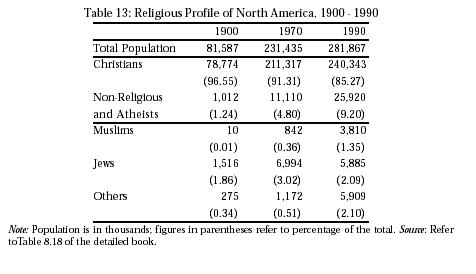
The share of Christians in the population of the continent seems to have declined from about 97 percent in 1900 to 85 percent in 1990. A large proportion of the change is because of an increase in the number of people counted as Non-Religious and Atheists; this increase has been especially large between 1970 and 1990. In 1990, of 282 million persons in the continent, 240 million are Christians and about 26 million Non-Religious or Atheists. If we take the latter to be part of the Christian mainstream, then the percentage of Christians in the population is nearly 95 percent.
There are about 6 million Jews in the North American continent. Their numbers rose from 1.5 million in 1900 to 7 million in 1970 and has since declined to 5.9 million. The continent, mainly the United States of America, thus hosts twice as many Jews as the state of Israel. They form about 2 percent of the population, slightly more than their share of 1.86 percent in 1900. In 1970, their share in the population was higher at 3 percent.
There are 3.8 million Muslims in North America, forming about 1.35 percent of the population. The presence of Muslims has increased substantially since 1970.
Latin America
Latin America is largely inhabited by people of European stock, though a fair number of Latin Americans today have a partially mixed ancestry. We present the data for the continent in Table 14.
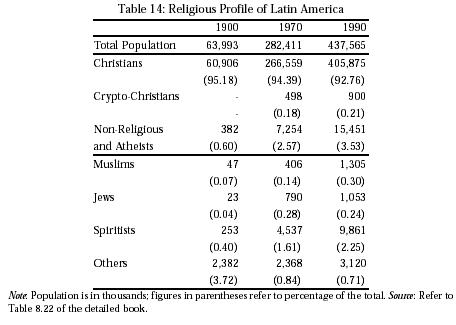
Latin America remains a Christian continent, even more so than Europe and North America, where the proportion of people formally counted as Christians has declined because of the rise in the number of people claiming to be Non-Religious and Atheists. In Latin America, only about 15.5 million of a total population of about 438 million choose to describe themselves thus. People counted as Non-Religious, New Religionists or Atheists form a substantial proportion of the population only in Cuba, Chile and Uruguay; in all other countries of the continent their proportion is less than 5 percent, in most around 2 to 3 percent.
Christians form nearly 93 percent of the population of Latin America; they have a similar or higher presence in almost every country of the continent, except the few mentioned above. If we take the crypto-Christians and those counted as Non-Religious, Atheists and New Religionists as part of the Christian mainstream, then the share of Christians in the continent rises to 96.5 percent. About 10 million persons in the continent are listed as “Spiritists”; 2.7 million of the Spiritists are in the Caribbean, most of them in Cuba, and 7.2 million in South America, mainly in Brazil.
There are about 1.3 million Muslims in the continent; their number has almost tripled since 1970 and they now form 0.3 percent of the population. About half of the Muslims are in Argentina. There are also about a million Jews in the region; their number has almost doubled since 1970. About 0.8 million of the Jews are in Brazil and Argentina.
Oceania
Oceania, comprising Australia, Fiji, New Zealand, Papua New Guinea and some smaller countries, is sparsely inhabited. In Table 15, we present a brief religious profile of Oceania.
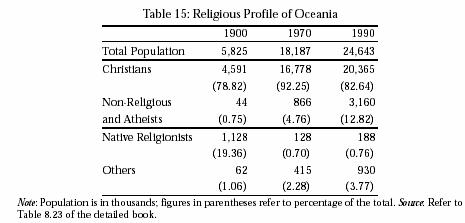
In 1900, Christians formed less than 80 percent of the population and about 20 percent were Native Religionists. During the twentieth century, the proportion of Native Religionists, who were the original inhabitants of the continent, has declined to less than 1 percent; their absolute numbers have come down from 1.1 million to 0.19 million. Most of the Native Religionists in Oceania today are in Papua New Guinea, where they form 3.7 percent of the population. This almost total elimination of Native Religionists is the main change that has occurred during the twentieth century in the religious demography of this continent.
Religious Profile of the World
Having studied the religious profiles of individual continents in some detail above, we now bring together the data for the world as a whole in Table 16. We have counted the Buddhists of India, East Asia and Southeast Asia with the Native Religionists of the respective regions. Persons counted as crypto-Christians, New Religionists, Non-Religious and Atheists in Europe, North America, Latin America and Oceania have been included amongst Christians along with the professing Christians of these continents. “Others” in the Table include Indian Religionists, Chinese Religionists, Buddhists and Native Religionists of Europe, North America, Latin America and Oceania; “Spiritists” of Latin America; and other minor religionists of the world that we have not counted separately. This Table provides a vivid picture of the presence and growth of the major religions of the world in the course of the twentieth century.
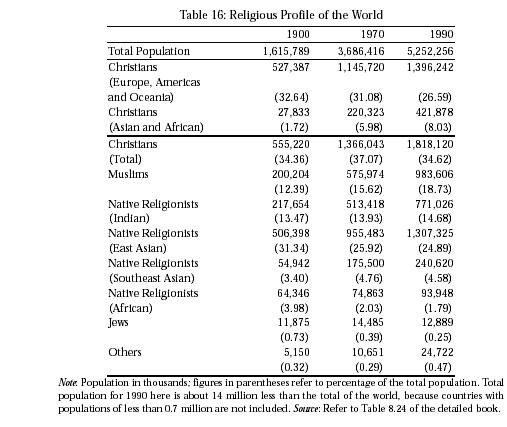
Christians
During the twentieth century, Christians have retained their share in the population of the world almost unchanged at around 34 percent. This has been made possible largely because of the inroads made by Christianity into previously non-Christian regions of the world, especially in Africa and to some extent in Asia. In 1990, about a quarter of 1.8 billion Christians in the world are in previously non-Christian continents of Africa and Asia. With the populations of Africa and Asia growing significantly fast during the twentieth century, the proportion of Christians in the world would have declined to about 26.6 percent if Christianity had remained confined to Europe, and the continents of North America, Latin America and Oceania that have been colonised by the people of European stock.
Of 422 million Christians outside Europe and the continents claimed by Europeans, 268 million are in Africa, where they form 44 percent of the population. They dominate almost all of South and Central Africa and much of East and West Africa. In 1990, they have a share of more than 80 percent in the populations of South Africa and Central Africa, of about 62 percent in the population of East Africa, and about 34 percent in that of West Africa.
In Asia, Christian success has been relatively limited. There are only 154 million Christians in Asia, forming less than 5 percent of the population. Of these, 55 million are in Philippines, which was Christianised already at the beginning of twentieth century. Other countries of Asia with substantial Christian populations are Indonesia with 18 million Christians, South Korea with 17 million and India with about 22 million. These three countries had few Christians in 1900; now they form about 10 percent of the population of Indonesia and 40 percent of South Korea. In India their proportion of the population at about 2 percent is not high, but as discussed earlier, they dominate in specific pockets of Indian Union and their numbers are fairly significant in the context of limited progress of Christianity in the Asian continent. Christians seem to be making significant gains also in some other countries of Southeast Asia, especially Myanmar, Malaysia and Taiwan.
Muslims
The share of Muslims in the population of the world has grown significantly from 12.4 percent in 1900 to 18.7 percent in 1990. They are the only religious group to have made such a large gain in their share of the world in the course of the twentieth century.
West Asia, Central Asia and North Africa have been the early homelands of Muslims. In Central Asia they continue to form about 95 percent of the population; in West Asia they have improved their share from 76 to 86 percent, leading to a corresponding decline in the Christian presence in the region; and in North Africa their share in the population has risen from 82 to 87 percent, with a corresponding decline in the share of Native Religionists of Africa. Of about 980 million Muslims in the world about 375 million, forming nearly 38 percent of the total, are in these three contiguous regions.
India, including Indian Union, Bangladesh and Pakistan, accommodates the next largest number of Muslims in the world. There are around 325 million Muslims here, divided almost equally between the three countries into which India has been divided during the twentieth century. Muslims in India today form about one-third of all Muslims in the world; and as we have discussed earlier, their share in the population of this region has improved by almost 8 percentage points since 1900 to reach about 30 percent in 1990.
Indonesia in Southeast Asia accommodates another about 100 million Muslims; their share in the population has risen by about 15 percent during the twentieth century. They now form about 55 percent of the population of the country. There are another 18 million Muslims in Southeast Asia, a majority of them in Malaysia and Philippines. They form about half of the population of Malaysia. In Philippines, their presence has risen to more than 6 percent from about 4 percent in 1970.
There are about 125 million Muslims in parts of Africa other than North Africa. They have made substantial gains in their share in these parts, especially in West Africa, where their share has gone up from about 25 to nearly 50 percent, and in East Africa, where their share has risen from 12 percent to 20 percent.
There are about 30 million Muslims in Europe, where their share in the population has almost doubled to 4 percent during the course of the twentieth century. About 20 million of them are in those countries of East and South Europe where they have had a substantial presence for long. But they have also significantly enhanced their presence in several countries of West and North Europe, particularly in France and Germany, which together accommodate about 7 million Muslims in 1990.
Of the remaining about 25 million Muslims, about 18 million are in China and the rest are spread across other parts of the world. During the course of the twentieth century, Muslims seem to have enhanced their presence in almost every part of the world, excepting only China, where even their absolute numbers have declined. But their gains have been the most spectacular in parts of Africa, and in Indonesia and India.
Jews
Jews are another group of people who have lost heavily in their share of the population of the world. In absolute numbers there were 11.9 million Jews in 1900; they amount to 12.9 million persons in 1990. During the course of the century their presence in Europe has declined from 2.5 percent to less than half a percent. Most of the Jews today live in North America and Israel.
Native Religionists of Asia and Africa
Native Religionists of Indian and Southeast Asian region have managed to slightly improve their share in the population of the world. The share of Native Religionists of East Asian region has, however, declined from about 31 to 25 percent. This is a reflection of the fact that the population of the countries of East Asia, mainly China, has grown slower than that of India and Southeast Asia.
The share of Native Religionists of Africa in the population of the world has declined from about 4 to less than 2 percent. This decline has occurred even though the population of Africa has grown fairly rapidly. Africa, as we have seen, has succumbed to Christianity and Islam, and the share of Native Religionists in the population of the continent has declined from about 60 to 15 percent